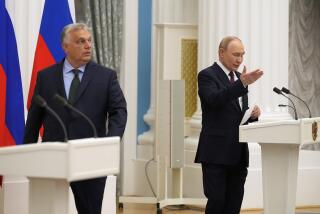Hungary Keeps a Low Profile Amid Upheaval : East Bloc: The nation is pleased over its role in triggering changes but is wary of a backlash.
HEGYESHALOM, Hungary — It began as an innovative publicity stunt--a “photo opportunity” intended to underline a reform-minded Hungarian government’s commitment to a free and democratic future.
“Everybody knew that words weren’t enough--not only for the West, but inside the country,” recalled Justice Minister Kalman Kulcsar in an interview Tuesday.
So last May 2, troops were ordered to begin tearing down sections of the 200-mile-long, barbed-wire border fence separating Hungary from Austria, punching the first holes in what the late Winston Churchill had dubbed the “Iron Curtain” separating East from West in Europe.
Little did officials in Budapest suspect that six months later, the process they began in this sleepy corner of Hungary would lead to an all-night champagne party atop the Berlin Wall to celebrate the newly proclaimed freedom of East Germans to travel in the West.
While pleased at the dramatic changes in East Germany and Tuesday’s first signals of hope from Prague, the Hungarians are reluctant to claim authorship. To do so would go against a conviction, ingrained over at least the last 30 years, that the best insurance of their own continued freedom to maneuver in the dangerous seas of East Bloc politics is the pretense that what they do has little effect on Moscow’s other allies.
But the trail of events from Hegyeshalom to Berlin tells a different story, underlining in unusually sharp focus the linkage of events as Eastern Europe lives its own “domino theory” of reform.
And after regional developments in the last few days, even the sometimes maddeningly pessimistic Hungarians are showing the trace of a national smile.
“There is a fear in this society because of (the ill-fated Hungarian uprising in) 1956, and because of the fundamentalist conspiracy against the democratic process here,” said Gabor Damszky, former dissident and a leader of the new Alliance of Free Democrats political party. “Germany means hope for us first of all--hope for a real, peaceful and quick solution.
“I think that now there is no way back,” Damszky added in an interview. “East Germany was the last stronghold of the empire in Eastern Europe. . . . dSoon we will be a part of greater Europe, and all of the Iron Curtain will be destroyed.”
The Iron Curtain went up here in the 1950s, after the pullback of Soviet troops from a newly neutralized Austria.
It was typical--barbed wire strung between concrete pillars with carefully swept tracks on either side to detect footprints, and watchtowers manned by soldiers with automatic weapons. Hidden mines, known euphemistically as “the technical barrier,” lurked inches below the surface of the earth in a 12-foot wide strip.
Officials started removing the mines in the mid-1960s after several grisly accidents, installing an electronic system that touched off alarms in the guard towers instead.
In recent years, the whole system had become largely an anachronism along perhaps the most friendly Cold War border that existed. The last bureaucratic barriers to free travel for Hungarians were removed last January.
So when troops were sent to dismantle the border fence, “it was like tearing down anything old and useless,” said a Hungarian journalist who requested anonymity.
“We realized that this was a dramatic gesture,” Kulcsar said of the decision. And they knew it might be a temptation for other East Bloc nationals to try and leave the region illegally. However, said Kulcsar, “we didn’t guess that this exodus would be so enormous.”
Thousands of East Germans, in Hungary on vacation, made for the border. It was even worse after last Aug. 1, when special regulations covering a one- to two-mile-wide “border zone” on the Hungarian side were relaxed.
Hungary was obliged under a bilateral 1969 treaty to turn back East German nationals from the Austrian border. But pressure built as the visitors began to overflow hastily organized refugee camps.
Finally, on Sept. 10, Foreign Minister Gyula Horn announced that Hungary was unilaterally suspending its agreement because of the failure of the two Germanys to come to some agreement between themselves over the refugees. The border was thrown open, and since then about 50,000 East Germans have crossed through Hungary into Austria and West Germany.
Joszef Szaszi, deputy editor of the government paper, Magyar Hilyap, recalled a senior official saying to him at the time: “With this action we made quite a substantial hole in the Berlin Wall.”
“Maybe if Hungary hadn’t let those East Germans go away--maybe nothing still would have happened” in East Germany, speculated Csaba Csaki, rector of Karl Marx University of Economic Sciences. “At least this (Hungarian decision) played a very, very important part” in subsequent developments.
Some Germans are still leaving through Hungary, despite last Thursday’s opening of that country’s border to the West--273 were reported last weekend.
But generally things are much quieter in the border area now. The crossing at Hegyeshalom could be between almost any pair of West European nations--16 lanes in each direction past modern passport control and customs stations.
More to Read
Sign up for Essential California
The most important California stories and recommendations in your inbox every morning.
You may occasionally receive promotional content from the Los Angeles Times.










